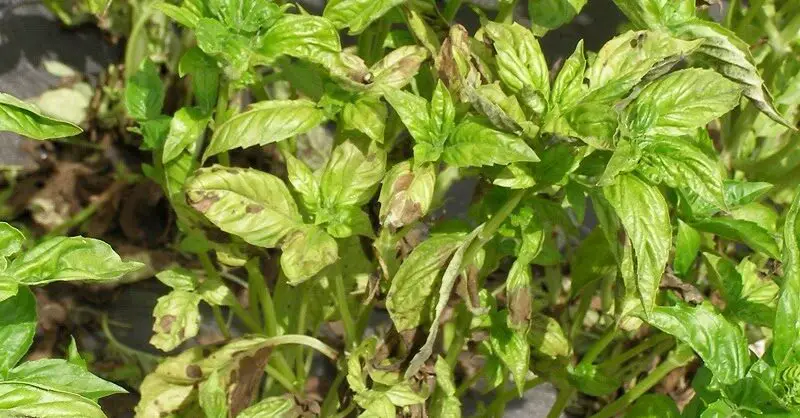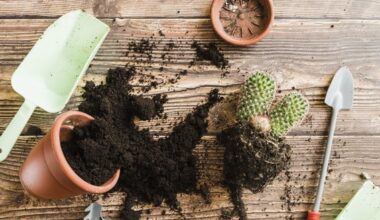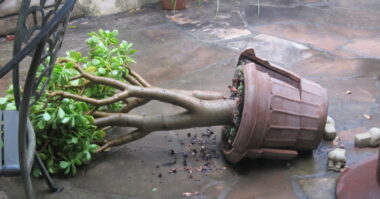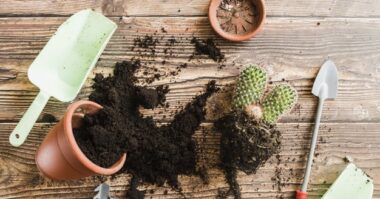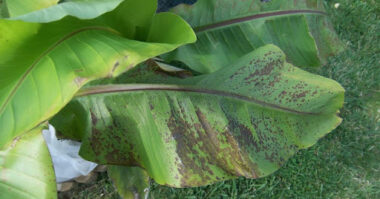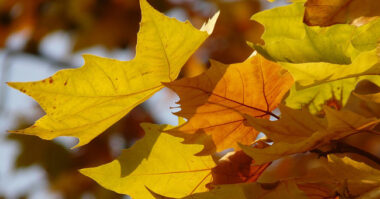Basil blight is a fairly recurring problem, but when you look closer, it is actually the beginning of a fungus outbreak, most often mildew, still grey mold. A hot and humid environment is the culprit.
Mildew is indeed a constant threat to the basil harvest. A preventive and regular treatment should ensure a good harvest without mildew blight.
Contents
Blight on the basil leaves?
Most of the time, burn/brown spots appear on the plant, these spots strongly resemble small burns, so the first reflex is to think that the plant is sunburned (yes, it can happen!).
In reality, it is either the beginning of a mildew disease, or grey mold (also called botrytis). In both cases, it is a fungus that causes abnormalities to appear on the leaves of your basilica. Here’s how to deal with these phenomena.
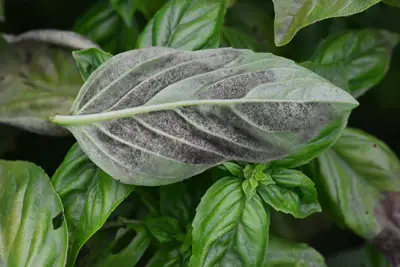
Mildew on basil
How to recognize mildew?
The plant turns brown! First the leaves, the edges dry out and turn brown, that’s why we talk about blight, then the fungus spreads all over the leaf, then it reaches the stem which turns brown too. Once in the stem, the fungus will be quick to attack the fruits or tubers. Tomatoes show brown bumps, they ripen with difficulty and eventually turn completely brown.
For potatoes, the leaves and stems turn brown and then the tubers rot. There is the smell too… The smell of putrefaction leaves no doubt, neither about the presence of the fungus, nor about the fact that you won’t risk tasting your vegetables!
Symptoms of mildew
Downy mildew is first characterized by the appearance of a few spots on the leaves and then spreads slowly throughout the foliage.
- It is a cryptogamic disease that mainly affects vines, tomatoes and potatoes.
- Brownish spots are formed in places on the leaves, which eventually turn completely brown and fall off.
When does mildew develop?
Mildew particularly likes hot and humid conditions and dense foliage that allows little air and light to pass through.
- Moisture is the main factor favouring its development.
- Like most cryptogamic attacks, mildew will tend to spread more easily after a shower.
- Airy, well-spaced basil will limit the spread of mildew.
The treatments adapted to the fight against mildew are fungicides whose action is essentially preventive. It is therefore imperative to treat during high-risk episodes (thunderstorm, rain, heat) in order to protect crops before the first symptoms are visible. Several treatments are recommended during the entire duration of the crop to effectively protect its plants.
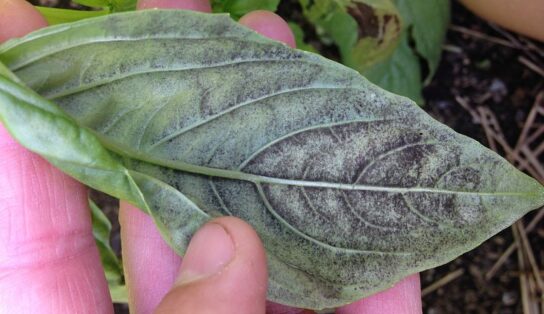
Grey mold on basil
How to recognize gray mold?
If young seedlings die in large numbers, so-called seedling meltdown, if in wet weather a grayish felting is visible on leaves, stems, flowers, fruit and even seeds, this is a manifestation of gray mold. Similarly, the sign of a soft, moist, brownish rot on picked fruit . Tissues affected by this mould wither and die quickly.
Symptoms of gray mold
Like the vast majority of fungi, botrytis develops in hot and humid weather. The optimal temperature for its development is between 18 and 20°C.
A wilting of the affected part is observed accompanied by a brown then grey felting (mould type). The affected part cannot heal, it ends up dying. If nothing is done, the botrytis spreads rapidly over the whole plant.
Fight against gray mold
Botrytis produces its harmful action especially on a plant weakened by harmful cultivation practices. It is thus necessary to first analyze what seems criticizable in the way of cultivating. Above all, ensure a good preparation of the soil, fertilize reasonably, weed if necessary, practice a mulching in relation to the climate, possibly keep away insects with a natural product such as nettle liquid manure…
This will help to obtain healthy subjects, thus more resistant to diseases. Greenhouse cultivation involves paying particular attention to good aeration around the plants and also, if necessary, to prune or thin out the leaves regularly during growth.
If the fungus still attacks, it is important to cut off the diseased parts early and carefully to avoid the dispersal of too many spores, then burn the waste and disinfect the cutting equipment. Then treat with natural herbal products such as horsetail or garlic decoction, to which sulphur or copper can be added as appropriate.
How to protect your basil against burns and fungus
Basil does not like soggy soils, but it is greedy for water. Keep the soil moist by watering daily, except when it rains, especially when growing in pots, and add mulch. Water the plants to avoid wetting the foliage, as moisture causes fungus formation. For the same reason, water early in the morning.
Summary
To sum up, most of the time, what is taken for a burn on basil, is often in fact mushrooms in formation. It is either mildew, or gray mold in 90% of cases.
The main reason is a hot and humid environment, which therefore favours the growth of the fungus. We go into more detail about these 2 diseases in this article.
